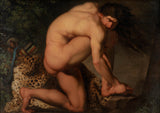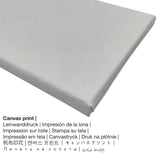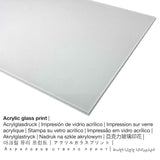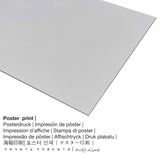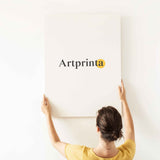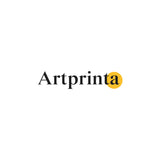Nicolai Abildgaard, 1775 - The Wounded Philoctetes - fine art print
Tax included. Shipping calculated at checkout.
About this more than 240 year-old painting
The over 240 year old artwork was created by the Danish painter Nicolai Abildgaard in 1775. The piece of art belongs to the Statens Museum for Kunst (National Gallery of Denmark)'s art collection, which is the largest museum of fine arts in Denmark and is attached to the Danish Ministry of Culture.. With courtesy of National Gallery of Denmark (public domain).: . What is more, the alignment is landscape and has a ratio of 1.4 : 1, which implies that the length is 40% longer than the width. Nicolai Abildgaard was a painter from Denmark, whose style can mainly be assigned to Romanticism. The Romanticist painter lived for a total of 66 years, born in 1743 in Copenhagen and died in the year 1809 in Copenhagen.
Product materials our customers can choose
In the dropdown selection right next to the article you can pick your prefered size and material. The following options are available for individualization:
- Acrylic glass print (with real glass coating): The print on acrylic glass, which is sometimes described as a UV print on plexiglass, makes the original work of art into wonderful wall décor and offers a distinct alternative to dibond and canvas prints. Your favorite artwork is manufactured with modern UV direct printing machines. The special effect of this are sharp and rich colors.
- Aluminium dibond print: An Aluminium Dibond print is a material with a true depth effect. The non-reflective surface structure creates a fashionable impression. A direct Aluminium Dibond Print is your ideal introduction to art replicas with aluminum. For our Direct Aluminium Dibond option, we print the favorite artpiece right onto the surface of the white-primed aluminum composite. This direct print on aluminium is one of the most popular entry-level products and is a truly sophisticated way to showcase art, since it puts the viewer’s focus on the image.
- The poster print (canvas material): The poster print is a UV printed canvas paper with a nice surface finish. Please note, that depending on the absolute size of the poster print we add a white margin of something between 2-6cm around the print motif, which facilitates the framing.
- Canvas print: The canvas print is a printed cotton canvas mounted on a wooden frame. Canvas prints are relatively low in weight. That means, it is quite simple to hang your Canvas print without any wall-mounts. Canvas prints are suitable for any type of wall in your house.
Legal disclaimer: We try our utmost to depict our products as closely as possible and to exhibit them visually on the respective product detail pages. Still, some colors of the print products and the print result might diverge somehwat from the presentation on your screen. Depending on your settings of your screen and the quality of the surface, not all colors are printed as exactly as the digital version. Because all fine art prints are printed and processed manually, there may as well be slight variations in the motif's size and exact position.
The product
| Product type: | art reproduction |
| Reproduction method: | reproduction in digital format |
| Manufaturing technique: | UV direct print (digital printing) |
| Product Origin: | produced in Germany |
| Stock type: | on demand |
| Intended product use: | home design, wall art |
| Alignment of the artwork: | landscape alignment |
| Aspect ratio: | 1.4 : 1 - (length : width) |
| Implication of aspect ratio: | the length is 40% longer than the width |
| Available product materials: | canvas print, poster print (canvas paper), metal print (aluminium dibond), acrylic glass print (with real glass coating) |
| Canvas on stretcher frame (canvas print) variants: | 70x50cm - 28x20", 140x100cm - 55x39" |
| Acrylic glass print (with real glass coating) variants: | 70x50cm - 28x20", 140x100cm - 55x39" |
| Poster print (canvas paper): | 70x50cm - 28x20" |
| Aluminium print (aluminium dibond material) size variants: | 70x50cm - 28x20", 140x100cm - 55x39" |
| Framing of the art copy: | without frame |
Work of art information
| Painting title: | "The Wounded Philoctetes" |
| Categorization: | painting |
| Art categorization: | classic art |
| Century: | 18th century |
| Created in the year: | 1775 |
| Artwork age: | around 240 years old |
| Museum: | Statens Museum for Kunst (National Gallery of Denmark) |
| Location of the museum: | Copenhagen, Denmark |
| Web URL: | Statens Museum for Kunst (National Gallery of Denmark) |
| License of artwork: | public domain |
| Courtesy of: | National Gallery of Denmark |
Short overview of the artist
| Name: | Nicolai Abildgaard |
| Gender of the artist: | male |
| Artist nationality: | Danish |
| Jobs: | painter |
| Country of origin: | Denmark |
| Classification of the artist: | old master |
| Art styles: | Romanticism |
| Died aged: | 66 years |
| Year born: | 1743 |
| Place of birth: | Copenhagen |
| Year of death: | 1809 |
| Died in (place): | Copenhagen |
This text is protected by copyright © | www.artprinta.com (Artprinta)
General information from Statens Museum for Kunst (National Gallery of Denmark) (© Copyright - Statens Museum for Kunst (National Gallery of Denmark) - Statens Museum for Kunst (National Gallery of Denmark))
From 1772 Abildgaard spent five years in Rome thanks to a scholarship granted by the Royal Danish Academy of Fine Arts in Copenhagen. It was while in Rome that he created this depiction of the legendary hero Philoctetes, whose screams of pain caused by a festering snakebite made his comrades-in-arms abandon him on a Greek island during the Trojan war.
Challenging neoclassicism The dominant and deeply rooted movement within figure painting at this time was neoclassicism with its emphasis on self-command and calm. Abildgaard challenges this pattern with his depiction of a body convulsively curved around an axis of pain; a body that feels like it is forcefully restrained within the picture field with its tense musculature and twisted limbs.
Avantgarde, pathos and Weltschmerz The 1770s brought with them an increased emphasis on grand passions among the Northern European ”avant-garde”, and this new outlook also left its mark on Abildgaard’s circles in Rome. The interest in pathos and Weltschmerz is clearly evident in his works from this era.
In this case he used a principal work of classical sculpture as the basis for his rendition of Philoctetes’ tormented state: The Torso Belvedere in the Vatican museum served as the model for the plastic and mannered rendition of the hero’s upper body. With this move, Abildgaard’s stylistic innovation was imbued with features of a work canonised by neoclassicism – without, however, reducing the tensions in the painting.

